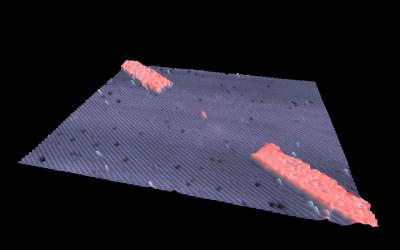Researchers of the University of New South Wales (UNSW) have developed a single atom transistor comprising only one atom in a silicon crystal.
 This is a single-atom transistor: 3D perspective scanning tunnelling microscope image of a hydrogenated silicon surface. Phosphorus will incorporate in the red shaded regions selectively desorbed with a STM tip to form electrical leads for a single phosphorus atom patterned precisely in the center.
This is a single-atom transistor: 3D perspective scanning tunnelling microscope image of a hydrogenated silicon surface. Phosphorus will incorporate in the red shaded regions selectively desorbed with a STM tip to form electrical leads for a single phosphorus atom patterned precisely in the center.
The microscopic transistor consists of a single phosphorus atom, which has been patterned between electrostatic control gates and atomic-scale electrodes.
Using a scanning tunneling microscope (STM), within a vacuum chamber, the UNSW physicists observed and manipulated the atoms on the crystal surface. On the crystal, the phosphorus atom has been patterned inside the operational device using a lithographic protocol. Subsequently, non reactive hydrogen has been layered on the crystal.
Using the ultra fine metal tip of STM, hydrogen atoms will be selectively desorbed in accurately defined areas and the phosphorus atoms will be integrated into the surface of the silicon under controlled reaction conditions. The whole set up will be encapsulated with a silicon layer. With electrical contact, the metallic connects will be aligned by complex alignment markers on the silicon surface.
Dr. Martin Fuechsle, the lead author of the paper and research fellow of UNSW, said that the tiny device has small markers carved on its surface. So, scientists will be capable of connecting metal contacts and applying voltage on the transistor. He was happy over his team’s achievement and added that the electronic features of the device perfectly matched with the theoretical calculations of Prof. Gerhard Klimeck's team at Purdue University and Prof. Hollenberg’s team at Melbourne University, who are also the co-authors of the paper.
It is expected that this single atomic precision can be used to improve the efficacy of quantum computers in future.
The paper was published in Nature Nanotechnology journal.